Australopithecus afarensis
Online Biology Dictionary
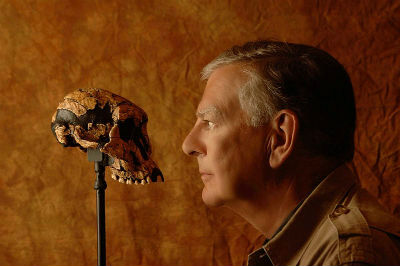 Donald Johanson with the Lucy skull (Australopithecus afarensis.
Photo: Wikipedia
Donald Johanson with the Lucy skull (Australopithecus afarensis.
Photo: Wikipedia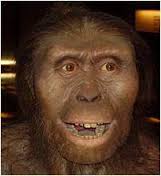 Reconstruction of A. afarensis.
Photo: Sumari
Reconstruction of A. afarensis.
Photo: Sumari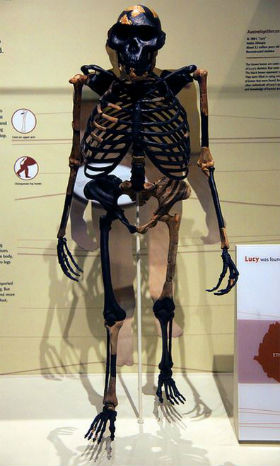 Reconstruction of the skeleton of A. afarensis (Enlarge image). Smithsonian, Washington, D.C. Image: Tim Evanson
Reconstruction of the skeleton of A. afarensis (Enlarge image). Smithsonian, Washington, D.C. Image: Tim Evanson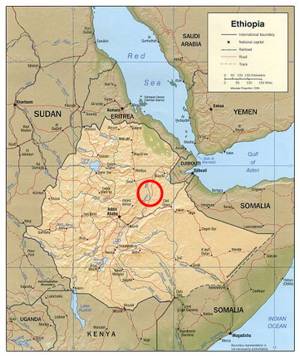 A. afarensis is known mainly from Hadar, Ethiopia (red circle).
A. afarensis is known mainly from Hadar, Ethiopia (red circle).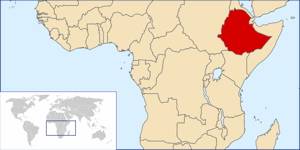 Location of Ethiopia.
Location of Ethiopia.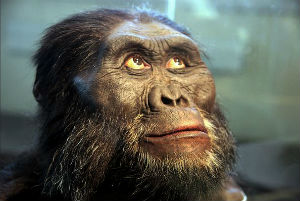 Reconstruction of A. afarensis (Enlarge image). Smithsonian, Washington, D.C. Image: Tim Evanson
Reconstruction of A. afarensis (Enlarge image). Smithsonian, Washington, D.C. Image: Tim Evanson
This hominid is one of the gracile australopithecines. Its known fossil range is approximately 2.7-4.0 mya, which makes it the precursor of Australopithecus africanus (2.0-3.0 mya, and the successor of Australopithecus anamensis (3.9-4.2 mya) (see Human Evolution Timeline >>).
Discoveries of Australopithecus afarensis remains have occurred only in eastern Africa (at Koobi Fora and Lothagam in Kenya; at Belohdelie, Fejej, Hadar, Maka, and Omo in Ethiopia; and at Laetoli in Tanzania). Most of the material has been collected in the vicinity of Hadar, in the Afar region of northeastern Ethiopia (see map) — So this is a hominid best known from Afar.
The Hadar site yielded the famous "Lucy," a set of skeletal remains (see picture, below right) from a single Australopithecus afarensis individual dating to 3.2 mya (Johanson and Maitland 1981). The sex of this specimen was inferred from pelvis morphology (i.e., width of the pelvic opening).
In life, Lucy had a height of approximately 1.1 meters (~3' 7") and weighed about 30 kilograms (~66 lbs). She was bipedal and yet had tne cranial capacity of an ape (Johanson and Maitland 1981), which shows that bipedalism preceded increase in brain size during the course of human evolution (this is under the assumption that it can be taken for granted that Lucy actually was ancestral to modern humans, a disputed point in scientific circles).
Certainly, the earliest indisputable proof of bipedalism in a hominid dates to the time of Australopithecus afarensis — Mary Leakey discovered actual footprints at Laetoli, similar to those of a small modern human being, preserved in hardened volcanic ash that, given their age (3.5 mya), were probably made by A. afarensis individuals (although Kenyanthropus platyops also dates to this period).
No shaped stone tools are associated with A. afarensis remains. However, a recent paper (Harmand et al. 2015) reports the discovery of such tools in Kenya that are contemporary with A. afarensis. They date to between 3.11 and 3.33 mya. Previously, the earliest stone tools known dated to approximately 2.5 mya (Semaw et al. 1997, Semaw 2000), A. afarensis which was consequently put out of the running as a stone tool maker.
There is no evidence that hominids of this type used fire. The habitat in which they lived, apparently, was a mixed savanna-woodland environment.
Lucy was discovered by Donald Johanson in 1974. Her skeleton is in the collection of the National Museum of Ethiopia in Addis Ababa, Ethiopia. Numerous additional A. afarensis fossils have been collected since the discovery of Lucy, but the remains of no other individual have been as complete.
|
Human origins >> |
Facts about Australopithecus afarensisHabitat: Savanna-forest mosaic. Pronunciation: AW-strail-ō-PITH-ə-cəs AF-ə-REN-səs. Etymology: The name of this hominid is constructed from the Latin prefix australo-, the Greek suffix -pithecus, the Latin suffix -ensis, and Afar, the region of Ethiopia where fossils of this type were first found. The name has the meaning "southern ape from the Afar." |
Australopithecus bahrelghazali >>